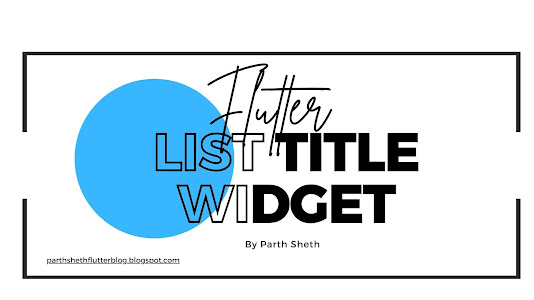Exploring the ListTile Widget in Flutter: A Comprehensive Guide
 Parth Sheth
Parth Sheth
Flutter, the open-source UI software development toolkit, has become a go-to choice for building beautiful and natively compiled applications for mobile, web, and desktop from a single codebase. One of the essential widgets in Flutter's arsenal is
ListTile. In this comprehensive guide, we will dive deep into theListTilewidget, exploring its features, use cases, and providing practical examples.Lets begin with the List Tile widget:
What is ListTile?
The ListTile widget allows developers to easily create a UI element that is both visually appealing and functional.
It allows developers to quickly create a list of related information, and provides an easy way to add leading and trailing widgets.
The List specification also ensures that the UI element is consistent with Material Design guidelines.
ListTile is a widget that helps to create a list of items. It is basically a row of information, which consists of a leading widget, title, subtitle, and trailing widget. It is very versatile and can be used in many contexts, such as creating navigation menus, displaying data in a list, and more.
Anatomy of a ListTile
- Before we delve into examples and use cases, let's break down the structure of a
ListTile:
Leading: This is the element that appears at the beginning of the
ListTile. It can be anIcon,Image, or any widget you want to place there.Title: The main title text that describes the item represented by the
ListTile.Subtitle: An optional secondary text that provides additional information about the item.
Trailing: Similar to leading, this element appears at the end of the
ListTile. It can also be anIcon,Image, or any other widget.OnTap: This is a callback function that gets executed when the
ListTileis tapped. It's used to handle user interactions.
Basic Usage of ListTile
Let's start with a simple example of how to create a basic ListTile:
ListTile(leading: Icon(Icons.star),title: Text('Star'),onTap: () {// Handle onTap action here},)In this example, we have an
Iconas the leading element, the title 'Star', and anonTapcallback that defines the action when the user taps theListTile.ListTile with Subtitle
Adding a subtitle is straightforward. You can simply include the
subtitleproperty:ListTile(leading: Icon(Icons.book),title: Text('Book'),subtitle: Text('A collection of stories'),onTap: () {// Handle onTap action here},)Now, the
ListTileincludes a subtitle providing additional information about the item.
ListTile with Trailing Widget
The trailing widget is often used for actions or additional information related to the item. Here's how you can include a trailing
Icon:ListTile(leading: Icon(Icons.email),title: Text('Email'),trailing: Icon(Icons.send),onTap: () {// Handle onTap action here},)In this case, the 'Email'
ListTilehas a 'send' icon as the trailing element.
ListTile in a ListView
To use
ListTilein a list view, you typically place them within aListViewor similar widget. Here's an example:ListView(children: <Widget>[ListTile(leading: Icon(Icons.phone),title: Text('Phone'),onTap: () {// Handle onTap action here},),ListTile(leading: Icon(Icons.camera),title: Text('Camera'),onTap: () {// Handle onTap action here},),// Add more ListTiles as needed],)This creates a scrollable list of
ListTileitems.
ListTile with Custom Styling
You can customize the appearance of
ListTileusing various properties. For instance, you can change the text color, background color, and more. Here's an example of custom styling:ListTile(leading: Icon(Icons.music_note),title: Text('Music',style: TextStyle(color:Colors.blue,fontSize: 18.0,fontWeight: FontWeight.bold,),),subtitle: Text('Your favorite tunes',style: TextStyle(fontStyle: FontStyle.italic,),),tileColor: Colors.yellow,onTap: () {// Handle onTap action here},)In this example, we've customized the text styles, background color, and added italics to the subtitle.
ListTile for Navigation
ListTileis commonly used in navigation drawers and side menus for app navigation. Here's an example of how to create a simple navigation list usingListTile:Drawer(child: ListView(padding:EdgeInsets.zero,children: <Widget>[DrawerHeader(child: Text('App Menu'),decoration: BoxDecoration(color:Colors.blue,),),ListTile(leading: Icon(Icons.home),title: Text('Home'),onTap: () {// Navigate to home screen},),ListTile(leading: Icon(Icons.settings),title: Text('Settings'),onTap: () {// Navigate to settings screen},),// Add more navigation options],),)In this example, we've created a simple app menu with
ListTileitems for navigation.ListTile for Dynamic Lists
Often, you'll need to generate
ListTilewidgets dynamically based on data. You can achieve this by using aListView.builder. Here's an example using a list of items:List<String> items = ['Item 1', 'Item 2', 'Item 3'];ListView.builder( itemCount: items.length, itemBuilder: (context, index) { return ListTile( title: Text(items[index]), onTap: () { // Handle onTap action for dynamic items }, ); },)In this case, the
ListView.buildercreatesListTilewidgets based on the contents of theitemslist.ListTile(leading: Icon(Icons.location_on),title: Text('Location'),subtitle: Text('Current location'),trailing: Icon(Icons.edit_location),onTap: () {// Handle onTap action here},)In this
ListTile, we have a location icon, title, subtitle, and an 'edit location' icon as the trailing element.ListTile for Selection
ListTilecan also be used in scenarios where users need to select items. You can use theselectedproperty to indicate the selected state. Here's an example:bool isSelected = false;
ListTile( title: Text('Selectable Item'), selected: isSelected, onTap: () { setState(() { isSelected = !isSelected; }); },)In this example, tapping the
ListTiletoggles its selected state.Conclusion
The
ListTilewidget in Flutter is a versatile and indispensable component for building elegant list-based interfaces in your Flutter applications. With its ability to handle icons, titles, subtitles, and trailing elements, it provides a wide range of possibilities for crafting user-friendly UIs.Whether you're designing a simple menu, a settings screen, or a dynamic list of items,
ListTileoffers the flexibility and customization options you need. You can adapt it to suit various styles and themes by tweaking its appearance and behavior to match your app's requirements.By mastering the
ListTilewidget and its features, you'll be better equipped to create intuitive and visually appealing Flutter applications that engage your users and deliver a seamless user experience. So go ahead, leverage the power ofListTileto take your Flutter development to the next level!Happy Coding!! 🙂
Subscribe to my newsletter
Read articles from Parth Sheth directly inside your inbox. Subscribe to the newsletter, and don't miss out.
Written by

Parth Sheth
Parth Sheth
"🚀 Fluttering through the digital cosmos, I am Parth Sheth, a passionate architect of interactive marvels in the realm of Flutter development. With a fervent love for coding and an insatiable curiosity for the ever-evolving tech landscape, I embark on a perpetual quest to redefine the boundaries of innovation. From sleek UI designs to seamless user experiences, I orchestrate symphonies of code that resonate with elegance and functionality. 💻✨ My journey in Flutter is more than just a profession; it's a thrilling odyssey where creativity meets craftsmanship. Armed with a keen eye for detail and an arsenal of cutting-edge tools, I navigate the complexities of app development with finesse, crafting solutions that not only meet but exceed expectations. 🎨🔧 But beyond the lines of code lies a deeper commitment—to inspire, empower, and elevate. Through my words, my work, and my unwavering dedication to excellence, I strive to ignite the spark of imagination in others, fostering a community where innovation knows no bounds. 🌟💡 So come, fellow adventurers, and join me on this exhilarating expedition into the unknown. Together, let's sculpt the future, one pixel at a time, and unleash the full potential of Flutter's boundless possibilities. Connect with me, and let's embark on this extraordinary voyage—together, we shall chart new horizons and redefine what's possible in the digital landscape. 🌍🔍"